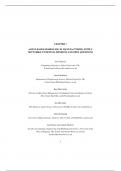Exam (elaborations)
AGENT-BASED MODELLING IN MANUFACTURING SUPPLY NETWORKS: POTENTIAL BENEFITS AND OPEN QUESTIONS
- Course
- Institution
networks may be transferred to the designed networks on which so much of modern life depends. The structure of this chapter is as follows. Section 2 describes in more detail the challenging modern manufacturing context within which goods and services are ordered, manufactured and distribut...
[Show more]



